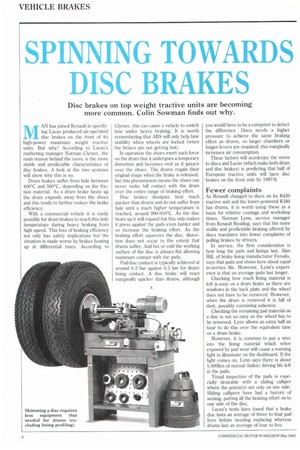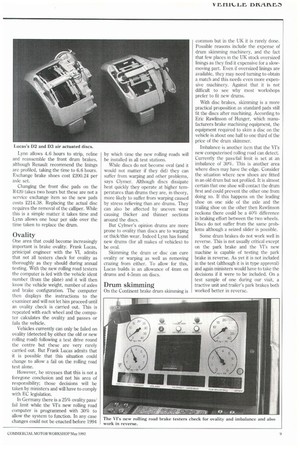SPINNING TOWARDS DISC BRAKES
Page 100

Page 101

If you've noticed an error in this article please click here to report it so we can fix it.
Disc brakes on top weight tractive units are becoming more common. Colin Sowman finds out why.
AiAN has joined Renault in specifying Lucas produced air-operated disc brakes on the front of its high-power maximum weight tractive units. But why? According to Lucas's marketing manager Norman Clymer, the main reason behind the move is the more stable and predictable characteristics of disc brakes. A look at the two systems will show why this is so.
Drum brakes suffer from fade between 400°C and 500°C, depending on the friction material As a drum brake heats up the drum expands away from the shoes and this tends to further reduce the brake efficiency.
With a commercial vehicle it is easily possible for drum brakes to reach this fade temperature during heavy braking from high speed. This loss of braking efficiency not only has safety implications but the situation is made worse by brakes heating up at differential rates. According to Clymer, this can cause a vehicle to switch lane under heavy braking. It is worth remembering that ABS will only help lane stability when wheels are locked (when the brakes are not getting hot).
In operation the shoes exert such force on the drum that it undergoes a temporary distortion and becomes oval as it passes over the shoes. The drums regain their original shape when the brake is released, but this phenomenon means the shoes can never make full contact with the drum over the entire range of braking effort.
Disc brakes dissipate heat much quicker than drums and do not suffer from fade until a much higher temperature is reached, around 900-950°C. As the disc heats up it will expand but this only makes it press against the pads even harder and so increase the braking effort. As the braking effort squeezes the disc, distortion does not occur to the extent that drums suffer. And hot or cold the working surface of the disc is always flat allowing maximum contact with the pads.
Pad/disc contact is typically achieved at around 0.2 bar against 0.5 bar for drum/ lining contact. A disc brake will react marginally quicker than drums, although you would have to be a computer to detect the difference. Discs needs a higher pressure to achieve the same braking effect as drums, so larger chambers or longer levers are required: this marginally increases air consumption.
These factors will accelerate the move to discs and Lucas (which make both drum and disc brakes) is predicting that half of European tractive units will have disc brakes on the front axle by 1997/8.
Fewer complaints
As Renault changed to discs on its R420 tractive unit and the lower-powered R340 has drums, it is worth using these as a basis for relative costings and workshop times. Norman Lynn, service manager from Renault Reading, says that the more stable and predictable braking offered by discs translates into fewer complaints of pulling brakes by drivers.
In service, the first consideration is how long the pads and linings last. Alan Hill, of brake lining manufacturer Ferodo, says that pads and shoes have about equal in-service life. However, Lynn's experience is that on average pads last longer.
Checking how much lining material is left is easy on a drum brake as there are windows in the back plate and the wheel does not have to be removed. However, when the drum is removed it is full of dust, possibly containing asbestos.
Checking the remaining pad material on a disc is not so easy as the wheel has to be removed. Lynn allows an extra half an hour to do this over the equivalent time on a drum brake.
However, it is common to put a wire into the lining material which when exposed by pad wear will cause a warning light to illuminate on the dashboard. If the light comes on, Lynn says there is about 1,6001un of normal (laden) driving life left in the pads.
Visual inspection of the pads is especially desirable with a sliding calliper where the piston(s) are only on one side. Sliding campers have had a history of seizing, putting all the braking effort on to one side of the disc.
Lucas's tests have found that a brake disc lasts an average of three to four pad lives before needing replacing whereas drums last an average of four to five. Lynn allows 4.6 hours to strip, reline and reassemble the front drum brakes, although Renault recommend the linings are profiled, taking the time to 6.6 hours. Exchange brake shoes cost £200.24 per axle set.
Changing the front disc pads on the R420 takes two hours but these are not a service exchange item so the new pads costs £214.38. Replacing the actual disc requires the removal of the calliper. While this is a simple matter it takes time and Lynn allows one hour per side over the time taken to replace the drum.
OVaiity One area that could become increasingly important is brake ovality. Frank Lucas, prinicipal engineer with the VI, admits that not all testers check for ovality as thoroughly as they should during annual testing. With the new rolling road testers the computer is fed with the vehicle ident number (from the plate) and it will then know the vehicle weight, number of axles and brake configuration. The computer then displays the instructions to the examiner and will not let him proceed until an ovality check is carried out. This is repeated with each wheel and the computer calculates the ovality and passes or fails the vehicle.
Vehicles currently can only be failed on ovality (detected by either the old or new rolling road) following a test drive round the centre but these are very rarely carried out. But Frank Lucas admits that it is possible that this situation could change to allow a fail on the rolling road test alone.
However, he stresses that this is not a foregone conclusion and not his area of responsibility; those decisions will be taken by ministers and will have to comply with EC legislation.
In Germany there is a 25% ovality pass/ fail limit while the VI's new rolling road computer is programmed with 30% to allow the system to function. In any case changes could not be enacted before 1994 by which time the new rolling roads will be installed in all test stations.
While discs do not become oval (and it would not matter if they did) they can suffer from warping and other problems, says Clymer. Although discs dissipate heat quickly they operate at higher temperatures than drums they are, in theory, more likely to suffer from warping caused by stress relieving than are drums. They can also be affected by uneven wear causing thicker and thinner sections around the discs.
But Cylmer's opinion drums are more prone to ovality than discs are to warping or thick/thin wear. Indeed Lynn has found new drums (for all makes of vehicles) to be oval.
Skimming the drum or disc can cure ovality or warping as well as removing crazing from either. To allow for this, Lucas builds in an allowance of 4mm on drums and 4-5mm on discs.
Drum skimming
On the Continent brake drum skimming is common but in the UK it is rarely done. Possible reasons include the expense of drum skimming machinery, and the fact that few places in the UK stock oversized linings as they find it expensive for a slowmoving part. Even if oversized linings are available, they may need turning to obtain a match and this needs even more expensive machinery. Against that it is not difficult to see why most workshops prefer to fit new drums.
With disc brakes, skimming is a more practical proposition as standard pads still fit the discs after machining. According to Eric Rawlinson of Hunger, which manufacturers brake machining equipment, the equipment required to skim a disc on the vehicle is about one half to one third of the price of the drum skimmer.
Imbalance is another item that the VI's new computerised rolling road can detect. Currently the pass/fail limit is set at an imbalance of 30%. This is another area where discs may have the edge. Consider the situation where new shoes are fitted in an old drum but not profiled. It is almost certain that one shoe will contact the drum first and could prevent the other one from doing so. If this happens on the leading shoe on one side of the axle and the trailing shoe on the other then Rawlinson reckons there could be a 40% difference in braking effort between the two wheels. Discs do not suffer from the same problems although a seized slider is possible.
Some drum brakes do not work well in reverse. This is not usually critical except on the park brake and the VI's new machine is capable of testing the park brake in reverse. As yet it is not included in the test (although it is in type approval) and again ministers would have to take the decisions if it were to be included. On a test sample of one during our visit, a tractive unit and trailer's park brakes both worked better in reverse.




















































































































